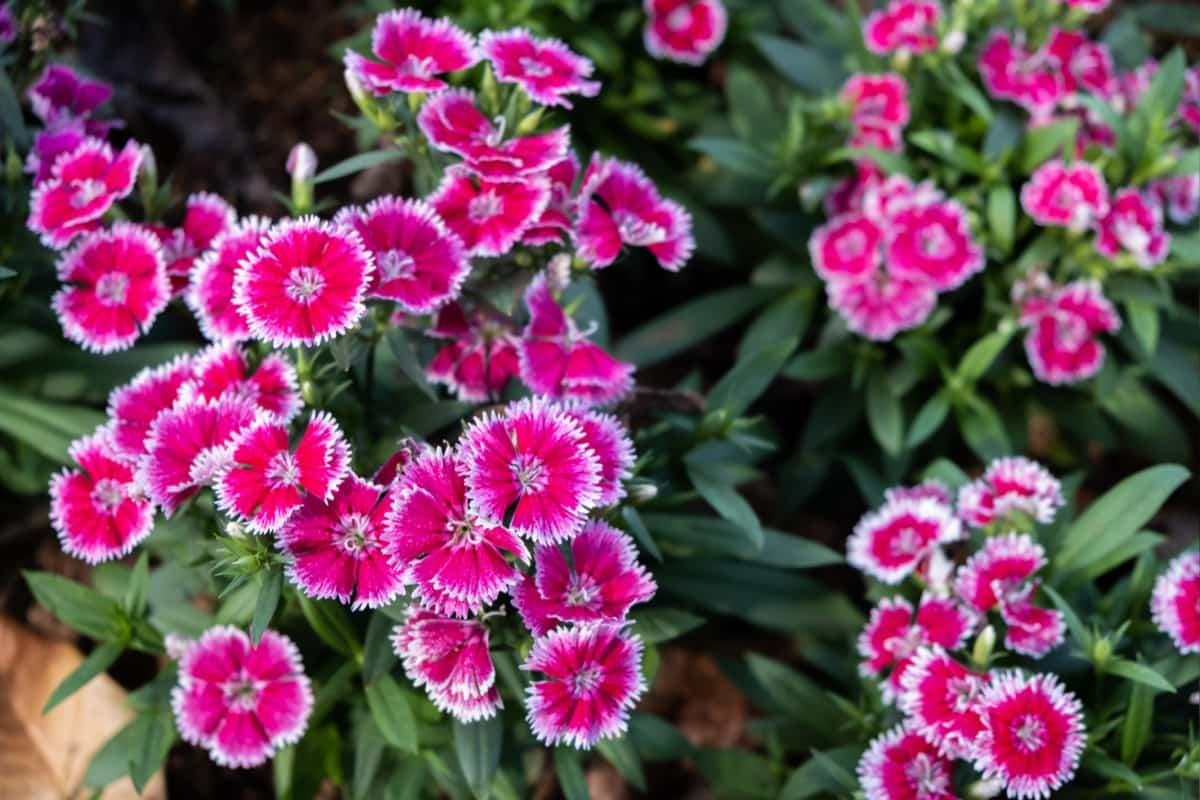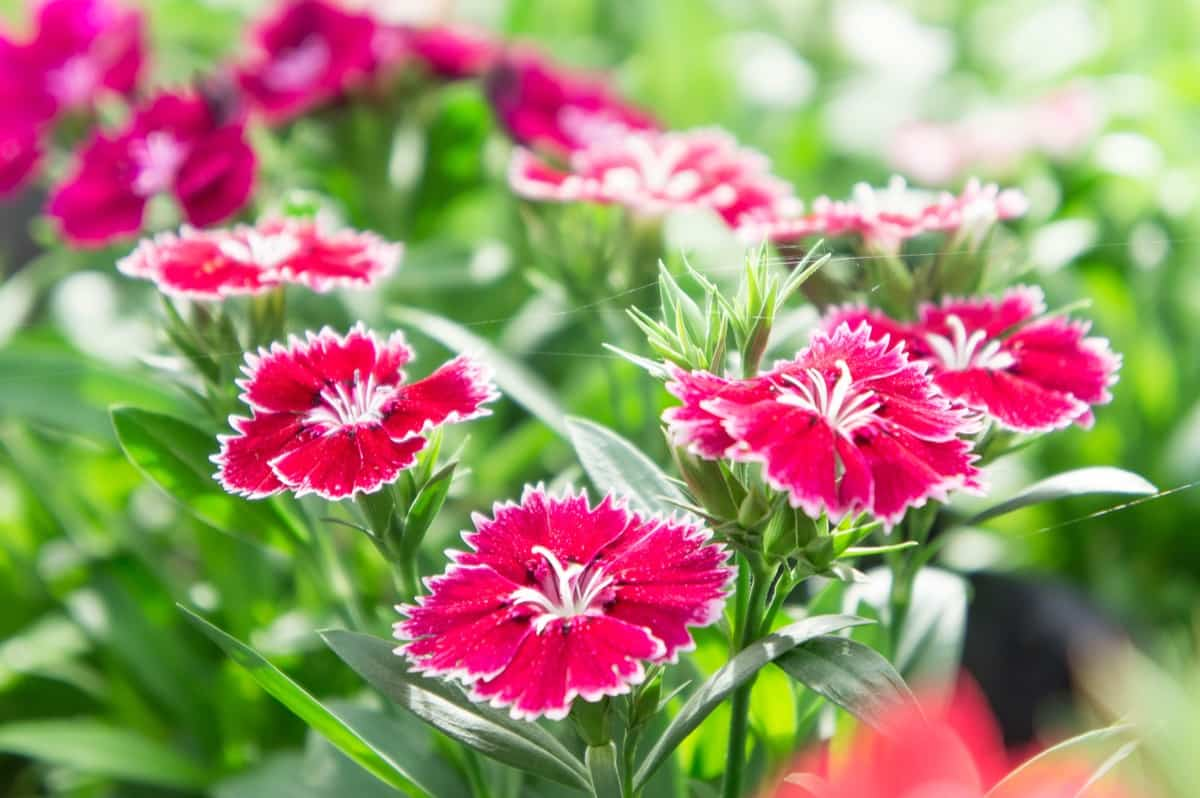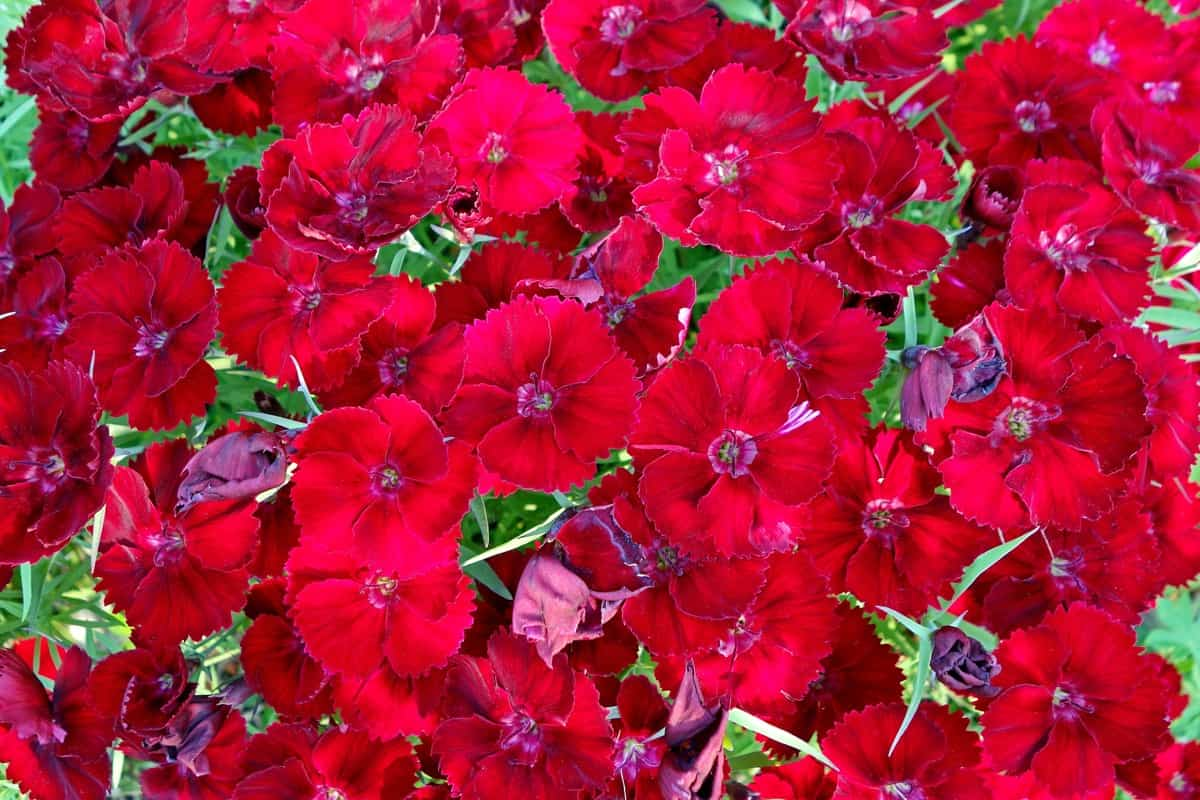An evergreen plant with beautiful, fragrant flowers, Dianthus can be grown throughout the year. You can grow them in pots or use them as border plants. It’s easy to grow, versatile, and pretty, so dianthus flowers should definitely be on your list! You have no reason not to add Dianthus flowers to your garden since so many varieties are available and easy to grow and care for.

Step-by-step Guide on How to Grow and Care for Dianthus
- Choose a location for planting your dianthus flowers. These plants require plenty of sunlight, so choose a spot that receives at least six hours of direct sunlight daily. Additionally, ensure that the soil is well-drained and rich in nutrients.
- Prepare the soil by removing rocks, weeds, and debris before planting. The soil should be tilled 12 to 15 inches deep with a fork or tiller. Compost or peat moss needs to be added to the soil to improve the quality.
- Dig a hole larger than the plant’s root ball. Dianthus should be placed in the hole, and soil should be filled around it. Remove any air pockets from the soil around the plant by gently pressing it.
- Water the Dianthus thoroughly after planting to help it establish its roots. Keep the soil moist but not waterlogged. Water the plant regularly, especially during dry spells.
- Fertilize the Dianthus monthly during the growing season with a balanced fertilizer.
- Prune the Dianthus regularly to promote bushier growth and more flowers. Pinch off spent blooms and trim back any leggy growth.
Best Soil and Sunlight Requirements for Dianthus
Soil Requirements
Dianthus plants prefer well-draining soil that is slightly alkaline with a pH between 6.0 and 7.5. They also need soil that is rich in organic matter. Mix compost or well-aged manure into the soil before planting to achieve this. Dianthus plants do not tolerate wet soil, so make sure the soil is well-draining to prevent root rot.
Sunlight Requirements
Dianthus plants need full sun to grow and bloom at their best. They need at least 6 hours of direct sunlight per day. If you live in an area with hot summers, providing some afternoon shade to protect the plants from scorching is beneficial.
Watering Schedule for Healthy Dianthus Plants
Water your dianthus plant thoroughly immediately after planting. Dianthus should be watered once a week. If the weather is consistently hot, increase to twice a week. Keep in mind that overwatering may lead to rot or mildew. During heavy rainfall or high humidity, it may be necessary to adjust the watering schedule to prevent overwatering. Overwatering causes root rot and other issues that can harm the plant.
Pruning Techniques for Dianthus Flowers
If you prune your dianthus plants properly throughout the year, you will have a greater chance of getting repeat blooms. When flowers have finished blooming, they should be deadheaded, especially on varietals known for repeat blooming. Remove any stems or leaves that appear diseased or damaged throughout the year. The plant should be pruned back until only 1 to 2 inches of stem remain above the soil. The plant goes dormant for the season and grows again in the spring.
Protecting Dianthus from Pests and Diseases
Pests
Besides spider mites and aphids, Dianthus plants may suffer from other common plant pests. You can treat an infestation with insecticidal soap or neem oil until all signs of it are gone.
Diseases
Copper-based fungicides are widely used in organic farming and gardening. They effectively control various fungal diseases, including powdery mildew, rust, and leaf spot. Thiophanate-methyl effectively controls fungal diseases, including powdery mildew, rust, and leaf spot. It is widely used in the ornamental plant industry to protect plants from fungal diseases.
Winter Care for Dianthus Plants
Dianthus are easy to care for in the winter, as they don’t require much attention. Plants should be cut back to the ground. Any dead stems or damaged parts should be removed. Mulch the area with a thick layer of insulating material.
- With sharp garden shears or hand pruners, cut back your dianthus plants.
- The area should be cleared of all dead or damaged stems and leaves.
- Shredded leaves or bark mulch should be applied thickly to your plants.
- The area should be watered lightly but not drenched.
- In the spring, mark the location of your plants so they can be identified.
- Move your container plants to a place that will protect them from winter storms if they are in containers.
In case you missed it: How to Grow and Care for Freesia: Planting Instructions for Beginners

Choosing the Right Dianthus Variety for Your Garden
- Know Your Growing Zone: Dianthus grows best in USDA zones 3-9, but some varieties may be better suited for specific zones. Ensure you know your growing zone before selecting a dianthus variety for your garden.
- Choose Your Preferred Color: Dianthus comes in various colors, including pink, white, red, and purple. Choose a color that complements your existing garden or landscaping.
- Determine Your Preferred Height: Dianthus varieties range from 6 inches to 2 feet. Consider how much height you want your plants to grow and select a variety that fits your preference.
- Look for Disease Resistance: Some dianthus varieties are more resistant to diseases like powdery mildew and rust. Consider selecting a disease-resistant variety to minimize the risk of plant damage.
Fertilizing Dianthus: Dos and Don’ts
Dos
- Do fertilize Dianthus in the spring. Use a balanced fertilizer with equal percentages of nitrogen, phosphorus, and potassium. The best fertilizer for Dianthus is an evenly balanced one with an NPK ratio of 10-10-10 or 20-20-20.
- Do apply fertilizer evenly around the base of the plant. Use a garden fork or other tool to mix the fertilizer into the soil lightly.
- Do water the plant thoroughly after fertilizing. This will result the nutrients reaching the roots and prevent burning.
- Do fertilize Dianthus every 4-6 weeks during the growing season. It ensures a steady supply of nutrients for healthy growth and blooming.
Don’ts
- Over-fertilizing the plant can cause damage to the roots and lead to stunted growth. Use the recommended amount of fertilizer and avoid applying it too frequently.
- Don’t fertilize during the winter months. Fertilizing during the winter can cause the plant to grow too quickly, leading to weak growth and reduced flowering.
- Don’t use a high-nitrogen fertilizer. High-nitrogen fertilizers can cause the plant to grow too quickly, leading to weak growth and reduced flowering. Use a balanced fertilizer instead.
- Don’t fertilize newly planted Dianthus. Newly planted Dianthus should not be fertilized for the first six months. Wait until the plant establishes its roots before applying any fertilizer.
Propagation Methods for Dianthus: Seeds Vs. Cuttings
Propagation from Seeds
- Seeds are one of the most common propagation methods for Dianthus. They are easy to obtain and can be sown directly into the soil bed or started indoors.
- Sowing seeds directly into the soil is the easiest and most cost-effective method. However, starting seeds indoors allows for more control over the growing conditions and can result in stronger seedlings.
- When starting Dianthus seeds indoors, it is important to use a well-draining soil mix and to keep the soil moist but not waterlogged.
- The seeds should be planted just below the soil surface and kept in a warm, well-lit area until they germinate. Once the seedlings have developed a few sets of true leaves, they can be transplanted outdoors.
Propagation from Cuttings
- Cuttings are another popular propagation method for Dianthus. This method involves taking a cutting from a healthy, mature plant and rooting it in soil or water.
- Cuttings can be taken at any time of year, but the best time is in the spring or early summer when the Dianthus plant is actively growing.
- Select a healthy stem and cut it just below a node to take a cutting. Remove the leaves from the bottom half of the stem, and dip the cut end of it into rooting hormone powder.
- Plant the cutting in a well-draining potting soil mix and keep it moist until it roots. Once the cutting has rooted, it can be transplanted to its permanent location.
In case you missed it: How to Grow and Care for Gaillardia: Planting Instructions for Beginners

Conclusion
By following these simple, caring instructions, you can easily plant, grow, and care for Dianthus. With its beautiful, fragrant flowers, Dianthus will surely be a favorite in your garden or indoor space for years to come.
- Ultimate Guide to Ossabaw Island Hog: Breeding, Raising, Diet, and Care
- Ultimate Guide to Juliana Pig: Raising Facts, Size, Diet, Care, and Lifespan
- Raising Lleyn Sheep: Disadvantages, Price, Uses, Characteristics, and Care
- Ultimate Guide to Meishan Pig: Breed Facts, Breeding, Raising, and Care
- Ultimate Guide to Teacup Pigs: Raising, Diet, Lifespan, Cost, and Care
- Guide to Raising Poll Dorset Sheep: Facts, Profile, Characteristics, Uses, and Care
- Ultimate Guide to Bighorn Sheep: Characteristics, Diet, Lifespan, Breeding, and Lifecycle
- Ultimate Guide to Raising Katahdin Sheep: Farming Facts, Breed Profile, Uses, and Care
- Ultimate Guide to Raising Oreo Cows: Belted Galloways Farming Facts, Profile, Uses, and Care